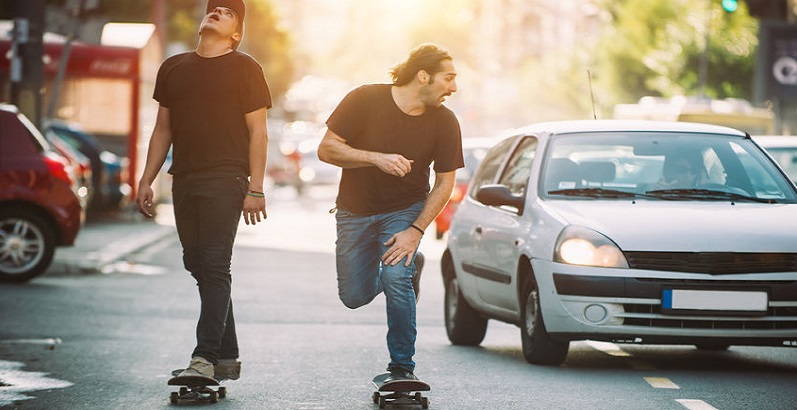The CDC notes that while there is no concussion-proof helmet, a skateboard helmet can protect you from personal injury if you’re involved in an accident.
Skateboarders Can Be Fined for Breaking Colorado Traffic Laws
Though more popular on college campuses around the country, skateboards are being used as a mode of transportation along city streets. Skaters can be found on roadways and city streets just as often as bicyclists, sometimes riding with no helmet and listening to music through headphones. Across the country, police officers are working to convey the message that skateboarders are not exempt from traffic laws.
Once Called “Sidewalk Surfing,” Skateboarding Has Been Around for Decades
Skateboards are an offshoot of roller skates that came about in the late 1950s when someone thought of taking a box and putting roller skates on it. Years later, skateboarding was all the rage, but as a recreational sport. Large skating areas began popping up around the country, consisting of downhill slaloms and freestyle skating areas. Skateboarding has now become so popular that the International Olympic Committee (IOC) voted unanimously in 2016 to include skateboarding as an Olympic event in the 2020 Tokyo Summer Games. Cities and college campuses are putting a greater emphasis on safety and rules in response to the announcement to ensure everyone is as safe as possible.
Individual Municipalities Regulate Skateboarding Laws
Most cities have laws on the books concerning activities such as skateboarding. These laws will vary from state to state and even town to town. Colorado’s laws were highlighted in an article not long ago after board riders in Fort Collins, especially around Colorado State University (CSU), found themselves with warnings from the police after being caught breaking traffic laws. According to the article, Fort Collins considers skateboards toys, which means skateboarders are not allowed on city streets, not even in biking lanes.
Around the country though, the biggest concern is that skateboarders are not aware of the laws they must obey, which can lead to dangerous situations for skateboarders as well as pedestrians, who can be injured if struck by someone on a skateboard. Such a situation did occur in San Francisco, and sadly, an elderly woman was killed when she was struck in a crosswalk. The woman was obeying pedestrian laws, but the skateboarder was not following city ordinances, which reportedly lead to the pedestrian accident.
One city that is ahead of the curve when it comes to skateboarding is Portland, Oregon. It is among a few cities to designate skateboarding as a mode of transportation and those doing so have the same legal rights as bicyclists. Nearly 20 years ago, Portland made it legal for skateboarders to use city streets but not sidewalks. To remain safe and on the right side of the law, it’s important to know the laws where you live as a skateboarder and a pedestrian.
Personal Injuries Resulting From Skateboard Accidents
A recent national news report noted a two-decade study on safety issues concerning skateboarding, and researchers found that during that time more than 64,000 children and teens were treated for skate-boarding related injuries. In that same period, five people were reported killed. Even skateboarding enthusiasts highlight the dangers of this activity if safety precautions are not taken, especially protecting the head. The Centers for Disease Control and Prevention has a lengthy fact sheet on helmets for skateboarders that provides valuable information. The CDC notes that while there is no concussion-proof helmet, a skateboard helmet can protect you from personal injury if you’re involved in an accident. A helmet should always be worn, along with wrist guards, knee and elbow pads, and properly fitting shoes.
In addition to personal safety precautions, skaters are also advised to inspect their board often for potential problems, such as cracked parts. They must also receive proper training to ride a skateboard. Learning how to slow down and practicing stopping and turning techniques are key to keeping yourself and those around you safe.

